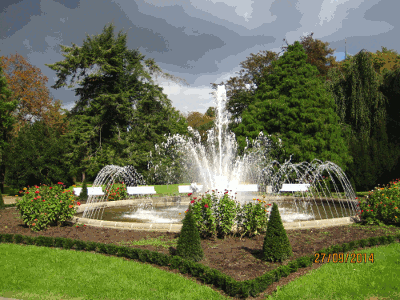Venue
- History of Freiberg
- Visa requirements
- Traveling to Freiberg
- What you should visit in Freiberg
- Additional Tourist Attractions around Freiberg
History of Freiberg
The city of Freiberg is a small university town near Dresden at the north side of the ore mountains (Erzgebirge in German). In fact, the "ore" naming these mountains was first discovered at the site which would become the city of Freiberg. Freiberg was founded in 1186 by Otto the Rich (Otto der Reiche) Margrave of Meissen, who had the great idea of allowing free men to dig for silver ore in Freiberg and was with that the inventor of free commerce in Europe. The silver mining of Freiberg made him and his family, and the whole Saxony, rich for hundreds of years, and was one of the reasons why the kingdom of Saxony kept its independence within the German domain until the XIXth century. Freiberg quickly became the capital city and economic center of the whole ore mountain mining region. In 1765, the world's first mining academy was founded here -- now the Technische Universitä:t Bergakademie Freiberg, celebrating its 250th birthday in the year of the conference.
With a population of about 45,000 inhabitants, Freiberg is still today
a small, successful university city. In recent decades, its business
profile has dramatically evolved, becoming an European center for photovoltaic
and silicon wafer industries. In
Freiberg, you may still visit active mines, albeit used only for education,
research, and tourism. Silver is no longer mined, but the heritage of mining
is evident wherever you go. Here, the University took
the initiative and made its history ready for the future by owning and
operating two mines: the "Reiche Zeche", the oldest, largest and last completely
operational mine of Saxony, as well as the "Alte Elisabeth". The many
well-preserved buildings from this period bear witness to Freiberg splendid
past. Not only the legendary mining heritage, but its unique medieval
architecture make the city a charming tourist destination.
Surrounded by
magnificent patrician houses on the Obermarkt (Upper Market), the statue of Otto
the Rich proudly overlooks the 15th century City Hall. Nearby, the oldest
municipal theater in the world is nowadays a busy cultural focal point.
Another highlight, the late gothic cathedral, "Freiberger Dom", that dominates the skyline of the "Untermarkt" (Lower Market) has several aspects that make it unique. One of the famous baroque Silbermann organs is found here, making an organ concert an absolute must for every visitor. The cathedral's art treasures include the romanesque Goldene Pforte (Golden Portal), the burial chapel of the Saxonian kings, and the tulip-shaped pulpit. Freiberg offers some fascinating museums and collections. Well worth a visit are both the Stadt-und Bergbaumuseum (Municipal History and Mining Museum) and the University's famous Mineralogische Sammlung (a mineral collection with extensive specimen). The 12th-century Castle Freudenstein has become home for the state mining archives and the world's largest and most exciting mineral collection organized by the University-Terra Mineralia. Visitors can enjoy a stunning mineralogical tour of remarkable and exquisite minerals from around the world and explore German mining history.
Visa requirements
Remember that citizens of some countries require a Visa to enter the European Union area, as listed here. Though visas are evaluated quite quickly, consider applying well in advance. You will find all the information relating to the process on the website of the German Federal Foreign Office. In particular, pay special attention to the requirements for the issue of short stay visas.Traveling to Freiberg

Freiberg is reasonably well connected with train to Dresden, with 30min-50min trip in new comfortable regional trains each hour, even more frequently in rush hours. Dresden has a regional airports served by many low-fare airlines from almost everywhere in Europe. Lufthansa and all Star Alliance airlines offer also combinations to Dresden airport in connection with their regular international flights to Munich and Frankfurt. Sky Team (Air France) offers the same via London City. Other companies (Etihad, Aeroflot, Vueling, AirBerlin, GermanWings) offer connections via Zurich or Amsterdam, Moscow, Barcelona, Palma de Mallorca and Stuttgart or Cologne. Connections to Berlin (both Tegel and Schönefeld airports) and traveling by train via Dresden are also possible.
- Flight plan Dresden Airport (Train station is "Dresden Airport")
- Star Alliance Flight Search
- Sky Team Flight Search
- Finding train connections in Germany (ATTENTION! You want to go to "Freiberg(Sachs)")
- Airports in Berlin
Finally, Freiberg has offices of several of the international car rental companies, thus the city is reachable from any of these airports with a one-way car rental. We are aware that, convenient as it may be, traveling to Freiberg may require a bit of extra time to combine flight and train/car. The conference schedule is adapted to this fact, offering early registration and assistance the whole Saturday and Sunday before the meeting.
What should you visit in Freiberg
- Terra Mineralia and Freundenstein Castle
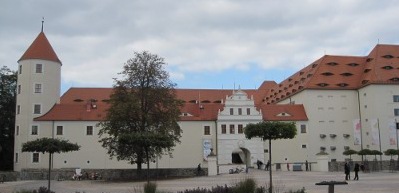 With 3500 different mineral, gems, and meteorites, Terra Mineralia is
one of the biggest mineral exposition of the world and definitive must for any geoscientist.
A visit of this exhibition before the ice breaker party on Sunday is included
in the conference fee. The exhibition is in the late Medieval castle in the city
center of Freiberg.
With 3500 different mineral, gems, and meteorites, Terra Mineralia is
one of the biggest mineral exposition of the world and definitive must for any geoscientist.
A visit of this exhibition before the ice breaker party on Sunday is included
in the conference fee. The exhibition is in the late Medieval castle in the city
center of Freiberg.
- "Alte Elisbeth" and "Reiche Zeche"
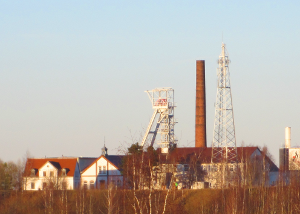
Hopefully, the underground mining system below Freiberg will be ready to visit during the conference. It is currently closed for tourists due to major reconstruction works. The mines were, before these works started, used as a teaching and research facility of the University. Visitors could safely venture to a depth of 230 meters along 14 kilometers of tunnels, and follow the history of mining in Freiberg back as far as the 14th century. Tours ranging from 1h to 5,5h for specialist were normally available.
- The protestant Cathedral of Freiberg
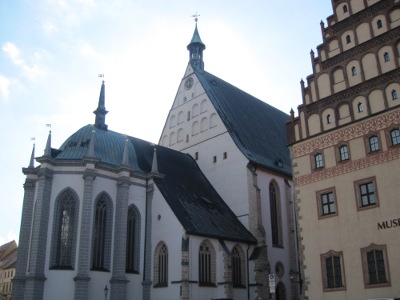
The dome is one of the few protestant cathedrals in Germany. It is famous for its organ build by Gottfried Silbermann, a first-class piece, and the "Goldene Pforte", one of the few cultural heritages that has experienced a respectful preservations through the times. Even in a time when it was normal to destroy old constructions and reuse their stones, after becoming obsolete this door was moved to another place in the church, and it is nowadays preserved from weathering indoor. It is not common to find such Romanesque piece of art so far north in central Europe, and it is as uncommon that it shows just images of heaven and salvation, and not the classical medieval dycothomy of good and evil, salvation and doom. You must take a guided tour to enjoy both, it is worth the few euros!
Additional tourist attractions around Freiberg
- Dresden
 The capital of Saxony-Dresden-is half an hour away. A city
rich with palaces, churches of famous names and theaters, it is definitively
worth a visit. The most famous attractions are the recently rebuilt
"Frauenkirche", the "Grünes Gewölbe", the "Zwinger" palace/garden
and the "Semper Oper" House.
The capital of Saxony-Dresden-is half an hour away. A city
rich with palaces, churches of famous names and theaters, it is definitively
worth a visit. The most famous attractions are the recently rebuilt
"Frauenkirche", the "Grünes Gewölbe", the "Zwinger" palace/garden
and the "Semper Oper" House.
- Meissen
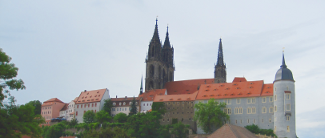 Meissen shares with Freiberg its Medieval heritage and being one of the economic
centers of Saxony 300 years ago. Meissen wealth came mainly from its
china manufacturing. Like Freiberg,
it offers a beautiful historic city center,
a castle and a cathedral as well
as a museum on its specialty (in this case, a china museum).
It is reachable by S-trains (suburban services) from Dresden,
and the visit to Meissen can be combined with a trip with a steam train
to the fortresses of Moritzburg and Radeburg from "Radebeul Ost" train station.
Meissen shares with Freiberg its Medieval heritage and being one of the economic
centers of Saxony 300 years ago. Meissen wealth came mainly from its
china manufacturing. Like Freiberg,
it offers a beautiful historic city center,
a castle and a cathedral as well
as a museum on its specialty (in this case, a china museum).
It is reachable by S-trains (suburban services) from Dresden,
and the visit to Meissen can be combined with a trip with a steam train
to the fortresses of Moritzburg and Radeburg from "Radebeul Ost" train station.
- Fortress Königsstein and the "Elbsandsteingebirge"
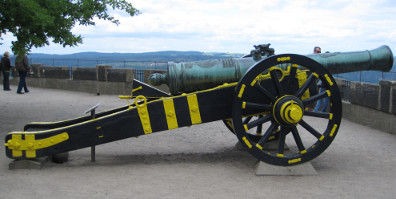 Königsstein was the "Fort Knox" of old Saxony,
a powerful fortress holding the treasury of the Saxonian kings in past
centuries. It is located in the "Elbsandsteingebirge", a scenery-rich sandstone
mountain formation just 20km south of Dresden, along the river valley of the Elbe. The valley features
steep cliffs resembling miniature versions of Alpine mountains.
The complex is reachable by S-trains (suburban services) from Dresden,
through the most impressive views may require one-day walking tours.
Königsstein was the "Fort Knox" of old Saxony,
a powerful fortress holding the treasury of the Saxonian kings in past
centuries. It is located in the "Elbsandsteingebirge", a scenery-rich sandstone
mountain formation just 20km south of Dresden, along the river valley of the Elbe. The valley features
steep cliffs resembling miniature versions of Alpine mountains.
The complex is reachable by S-trains (suburban services) from Dresden,
through the most impressive views may require one-day walking tours.
- Augustusburg Castle
Augustusburg is the largest and most famous of the Saxonian castles. It is located southwest of Freiberg and hosts several museums. Guided tours introduce visitors to the old world of margraves and dukes of Saxony.

